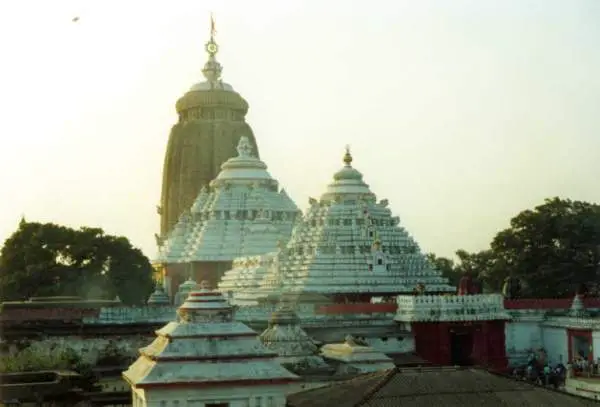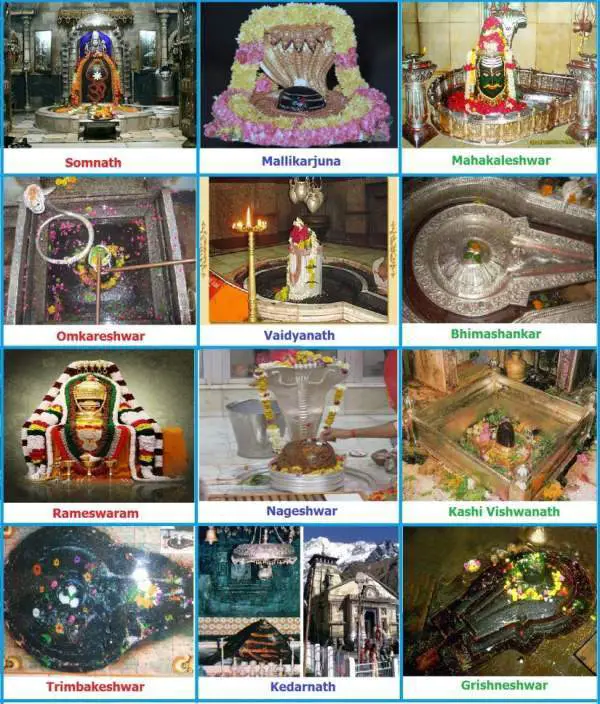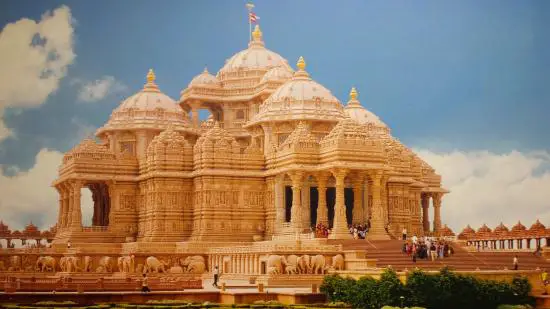Ashtavinayaka refers to the eight most important Lord Ganesh temples that are situated in the state of Maharashtra, India.
In fact, Ashtavinayaka is a Sanskrit word which means “Eight Ganeshas.” The Ashtavinayak Yatra is an important pilgrimage destination for the devotees of Lord Ganesh that covers the eight most holy and ancient temples of Lord Ganesh.
Today, we will share with you all the eight Ashtavinayaka temples that are situated in Pune, Raigad, and Ahmednagar districts of Maharashtra.
Each of these Ashtavinayak temples comes with their own individual history and legend that are distinct from each other. In fact, each “murti” of Lord Ganesh (including His trunk) are distinct from others. It is said that to complete the Ashtavinayak Yatra one needs to visit the first Ganapati again after visiting all the eight Ganapati.
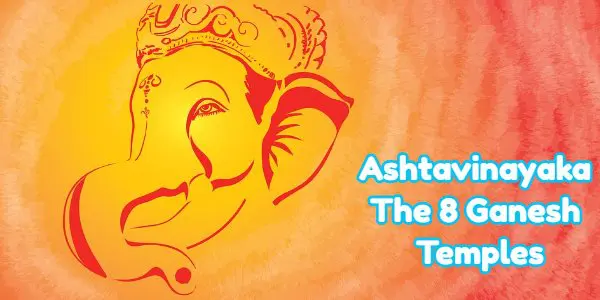
The list of Ashtavinayak Temples (in their religious sequence) are as follows:
- Moreshwar Temple – Morgaon in Pune District
- Siddhivinayak Temple – Siddhatek in Ahmednagar District
- Ballaleshwar Temple – Pali in Raigad District
- Varadavinayak Temple – Mahad (near Khopoli) in Raigad District
- Chintamani Temple – Theur in Pune District
- Girijatmaj Temple – Lenyadri in Pune District
- Vighneshwar Temple – Ozar in Pune District
- Mahaganapati Temple – Ranjangaon in Pune District
So, Moreshwar Temple of Morgaon is the first temple in the Ashtavinayak Yatra. The pilgrims then visit Siddhatek, Pali, Mahad, Theur, Lenyadri, Ozar, and Ranjangaon in descending order. The Ashtavinayak Yatra is said to conclude with a second visit to Morgaon.
All the Ashtavinayaka murtis are self-existent or Swayambhu effigies meaning that they were not sculpted but were found formed by nature.
Table of Contents
8 Ashtavinayak Temples
Now, we offer you the details of the Ashtavinayak Temples in their religious sequence:
1. Ashtavinayak Mayureshwar Temple
The Mayureshwar Temple is located in the Morgaon village at a distance of 55 km from Pune. It is located amidst the center of the village. It is said to be the most important temple in the Ashtavinayak Yatra.
The temple was built during the Bahamani reign. It has been built using black-stone. Mayureshwar Temple has four gates. It has 50 feet tall wall around it.
In fact, the temple gives the feeling of a mosque as it has been covered by four minarets from all sides. It was done to prevent attacks on it during the Mughal period.
The uniqueness of this temple is the Nandi shrine (Lord Shiva’s bull mount) that sits at the entrance of the temple. Usually, Nandi is found in Shiva temples only. The story goes that this Nandi shrine was being carried to some Shiva temple. However, the vehicle that was carrying the Nandi statue broke down, and it was never removed from this current place.
Here, the murti of Lord Ganesh is in the form of Mayureshwar that rides a peacock. It is said that Lord Ganesh slained the demon Sindhu at this spot. The idol of Lord Ganesh has its trunk turned to the left. There is also a cobra (known as Nagaraja) that is poised over it. This form of Lord Ganesh has two other murtis of Siddhi (refers to capability) and Riddhi (refers to intelligence).
However, the murti which is currently worshiped is not the original one. The original murti is placed behind it. It is smaller in size and is made of sand, iron, and diamonds.
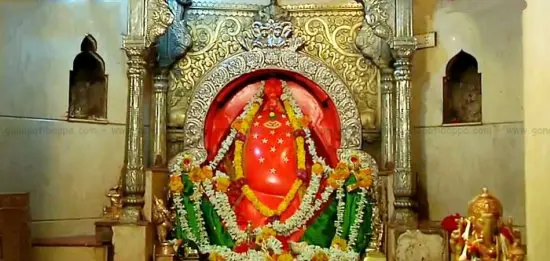
2. Ashtavinayaka Siddhivinayak Temple
It is the only temple in the Ashtavinayak Yatra in which the Lord Ganesh murti has trunk positioned to the right.
It is said that Lord Vishnu vanquished the demons Madhu and Kaitabh after propitiating Ganesha here.
Saints such as Shri Morya Gosavi and Shri Narayan Maharaj of Kedgaon got their enlightenment here.
The Siddhivinayak temple is situated on a small hillock. It is a North-facing temple. Its inner sanctum is 15 feet high and 10 feet wide. It was built by Ahilyabai Holkar. The Ganesh idol here is 3 feet tall and 2.5 feet wide. It faces the North direction. The Riddhi and Siddhi murtis have been seated on one thigh. The murti’s trunk is turned towards the right. Its stomach is not wide. One needs to make a round trip of the hillock to complete one round of pradakshina around the temple. It takes 30 minutes with moderate speed.
There is an interesting history related to the temple. When the Peshwa General lost his General’s position, he did as much as 21 pradakshina around the temple. On the 21st day, the Peshwa’s court-man came to see him and invited him to the court. They took Haripant to court with royal honor.
The Siddhivinayak temple is situated off the Pune-Solapur highway in Ahmednagar district. It is about 48 km from the town of Srigonda. It is next to the Bhima River.
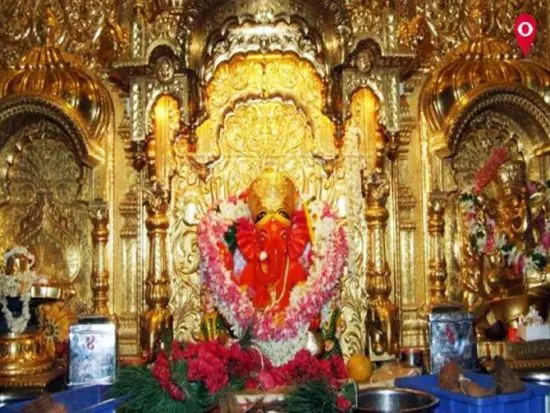
3. Ashtavinayak Ballaleshwar Temple
The Ballaleshwar Temple was reconstructed by Nana Phadanavis in 1760. The temple has two small lakes on its two sides. One of them is used for worshiping Lord Ganesh.
It is believed that Lord Ganesh saved the boy-devotee, Ballal when he was beaten by his father (Kalyani-Seth) and the local villagers for his undeterred devotion towards Him.
The temple faces the eastern direction. It has two sanctums. The inner one houses the Ganesha’s murti. It also has a Mushika (Lord Ganesh Vahana – mouse) that has modak in its forepaws. The hall has eight exquisitely carved pillars depicting the eight directions.
The inner sanctum is 15 feet tall, and the outer sanctum is 12 feet high. The temple has been built using stones that are joint together very tightly with melted lead. The sun’s rays fall on the Ganesha murti at sunrise after the winter. The Ganesha murti has diamonds that are embedded in the eyes and navel. Another specialty of this temple is the Prasad that is offered to the Lord Ganapati idol. It is made of Besan laddu instead of the usual Modak.
The temple is situated in the town of Pali, off the Mumbai-Pune Highway. It is about 30km to the South-West of Karjat Railway station.
There is the temple of Shri Dundi Vinayak behind this temple. It is a very rare idol which faces the West. It is the same idol which was thrown by Ballala’s father, Kalyani-Seth, while Ballala was worshiping it.
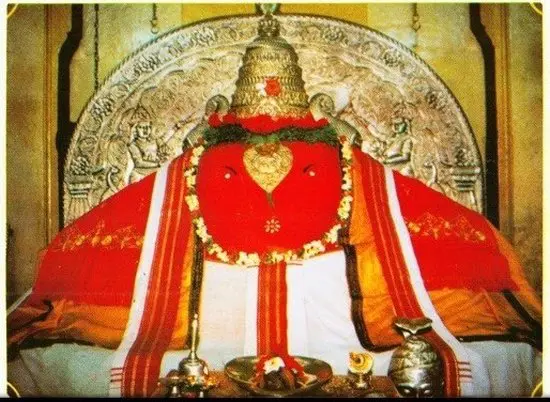
4. Ashtavinayaka Varada Vinayak Temple
Lord Ganesh is worshiped in this temple in the form of Varada Vinayak who is the giver of bounty and success. The idol was found by Dhondu Paudkar in 1690 AD in the adjoining lake in an immersed position. However, the Varadavinayak temple was built by the then Kalyan subhedar by Ramji Mahadeva Biwalkar in 1725 AD in the village of Mahad.
The idol of Lord Ganesha here faces the east, and its trunk is directed towards the left. An oil lamp is in the constant company of this idol ever since 1892. There are four elephant idols on the four sides of the temple. The central hall is 8 feet by 8 feet in size.
Its dome is about 25 feet in height. The dome shows up some designs of a cobra. The devotees can pay their homage and respects to the idol. Moreover, they can perform their prayers in the immediate vicinity of this idol.
The temple is located near Khopoli (80km from Pune) off the Mumbai-Pune highway. Karjat Railway Station is 24km from this place.
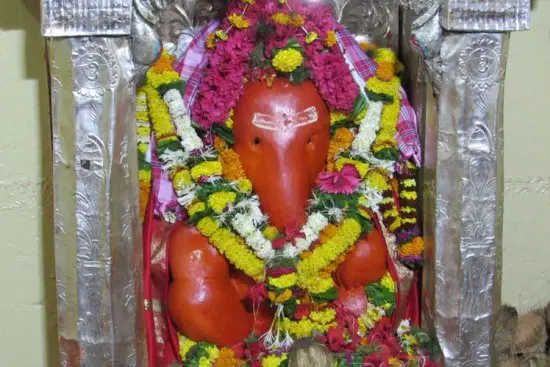
5. Ashtavinayak Chintamani Temple
There is a very interesting and popular legend associated with the Chintamani Temple. It is believed that Lord Ganesha got back the precious Chintamani jewel for sage Kapila at this place. However, Sage Kapila adorned Lord Ganesha with the Chintamani jewel. So, Lord Ganesh is called as Chintamani Vinayak. This incident happened under the Kadamb tree. So, Theur was known as Kadambanagar in olden times.
The Chintamani temple faces the Northern direction. There is a lake that is situated behind the temple, which is known as Kadambteertha. Its outer wooden hall was built by the Peshwas. The main temple was built by Dharanidhar Maharaj Dev who hails the family lineage of Shri Moraya Gosavi.
The idol of Lord Ganesh has a left trunk. It is studded with diamonds and carbuncle in its eyes. The idol faces the eastern side.
The Chintamani temple is situated off the Pune-Solapur highway and is 22km from Pune. It is located in the village of Theur which is at the confluence of three major regional rivers such as Mula, Mutha, and Bhima.
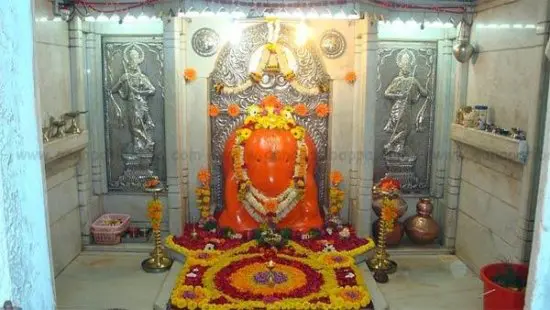
6. Ashtavinayaka Girijatmaj Temple
According to popular legend, Parvati (Lord Shiva’s wife) performed immense penance to beget Lord Ganesha at this spot. So, Girija or Parvati son is known as Girijatmaj.
The temple is situated amidst a cave complex that has 18 caves of Buddhist origin. In fact, the Girijatmaj temple is the 8th cave. The temple was carved out of a single stone hill and 307 steps. The temple has a wide hall that has no supporting pillars. Its hall is 53 feet in length, 51 feet wide, and 7 feet in height.
Here, the idol of Lord Ganesh faces the Northside and its trunk is turned to the left. It is worshiped from the rear of the temple. Moreover, the temple faces the south direction.
However, the idol of Lord Ganesh is not well carved or designed like other Ashtavinayaka idols. The idol here can be worshiped by anyone. The Girijatmaj Temple has been constructed in such a way that during the day it is always lighted up by the sun rays. However, there is no electric bulb in the temple.
The temple is situated on the Pune-Nashik highway and is about 94 km from Pune. Nearest railway station to this place (Lenyadri) is Talegaon. It’s a great location.
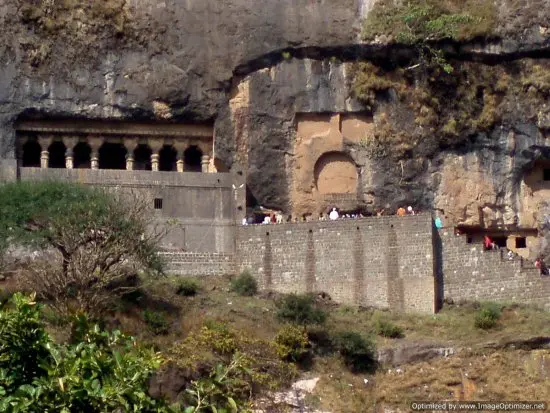
7. Vighneshwar Temple
The legend associated with the Vighneshwar idol states that once there was a demon named Vighnasur. He was created by Indra (the King of Gods) to destroy the prayers held by King Abhinandan.
However, Vighnasur went a step further and destroyed all religious acts and Vedic rites. Here, Lord Ganesha intervened and answered people’s prayers by defeating the demon.
However, the demon Vighnasur pleaded to Lord Ganesh and requested him to show mercy. Lord Ganesh granted his plea but put a condition that the demon should not visit the place where Ganesha worshiping is being held.
Vighnasur surrendered to this and wanted a favor that his name should be taken before the Lord’s name. Hence, Ganesha became Vighneshwar or Vighnahar. Moreover, Ganesha here came to be known as Shri Vighneshwar Vinayak.
The Vighneshwar temple faces east and is surrounded by a thick wall of stone. The main hall of the temple measures 20 feet in length, whereas the inner hall is 10 feet long.
The Lord Ganesh idol faces the east, and its trunk is turned towards the left. It has rubies in its eyes. Plus, it has a diamond in its forehead and jewels in the naval. There are idols of Riddhi and Siddhi on the two sides of the idol of Lord Ganesha. The temple top is set in gold. Vighneshwar temple was built in 1785 CE.
The temple is situated in the town of Ozhar off the Pune-Nashik highway on the banks of river Kukadi.
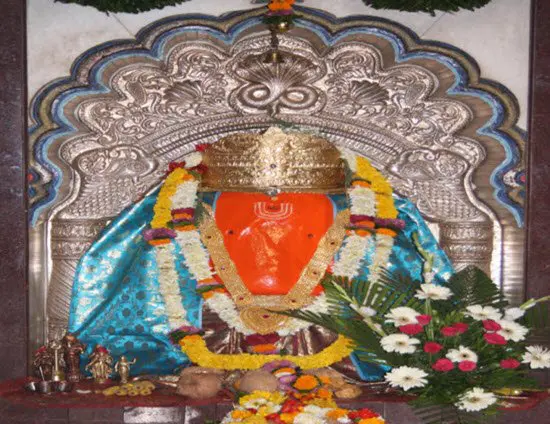
8. Mahaganapati Temple
According to the legend, Lord Shiva worshiped Ganesh here before He fought the demon Tripurasura. This temple was built between the 9th and 10th century. The temple is located in Ranjangaon, which is about 50km from Pune.
The Ganesha idol here has been seated in a cross-legged position and faces the east. It has a broad forehead and its trunk points to the left. However, there is another idol, which is called as the original idol and is hidden in the basement. It has 10 trunks and 20 hands. It is called as Mahotkat.
Mahaganapati is portrayed as seated on a lotus. He is flanked by his consorts Riddhi and Siddhi.
The temple was built during the rule of the Peshwas. The inner sanctum of the temple houses the Swayambhu (naturally found) idol of Lord Ganesha. The statues of Jay and Vijay guard the main gate of the temple.
Ganesh Chaturthi is celebrated with great splendor in this temple every year.
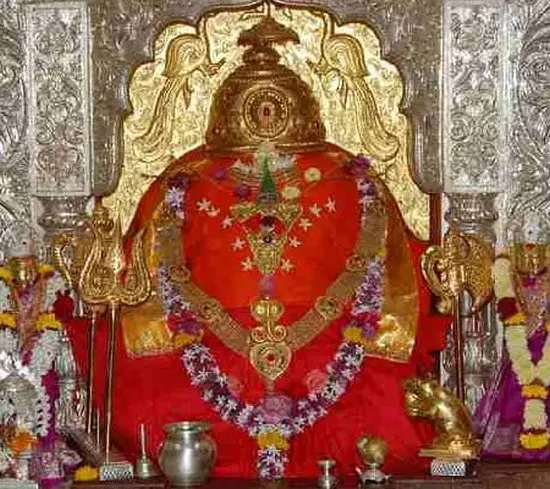
So, that’s all we have for you in this post on Ashtavinayak temples. We have shared with you Ashtavinayaka list along with the eight Ganesha temples in the Ashtavinayak Yatra of Maharashtra. We hope you enjoyed reading the post. Thanks for visiting. Please share the post across popular social networking channels. We welcome your comments and suggestions.

